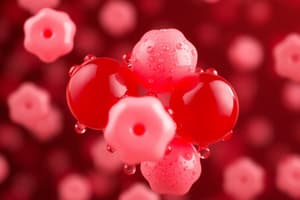Podcast
Questions and Answers
Erythrocytes, leucocytes and platelets are collectively called ______ elements.
Erythrocytes, leucocytes and platelets are collectively called ______ elements.
formed
A healthy adult man has, on an average, 5 millions to 5.5 millions of ______ mm–3 of blood.
A healthy adult man has, on an average, 5 millions to 5.5 millions of ______ mm–3 of blood.
RBCs
RBCs are formed in the ______ bone marrow in the adults.
RBCs are formed in the ______ bone marrow in the adults.
red
RBCs are devoid of ______ in most of the mammals and are biconcave in shape.
RBCs are devoid of ______ in most of the mammals and are biconcave in shape.
A healthy individual has 12-16 gms of ______ in every 100 ml of blood.
A healthy individual has 12-16 gms of ______ in every 100 ml of blood.
Leucocytes are also known as ______ blood cells (WBC) as they are colourless due to the lack of haemoglobin.
Leucocytes are also known as ______ blood cells (WBC) as they are colourless due to the lack of haemoglobin.
______ are the most abundant cells (60-65 per cent) of the total WBCs and basophils are the least (0.5-1 per cent) among them.
______ are the most abundant cells (60-65 per cent) of the total WBCs and basophils are the least (0.5-1 per cent) among them.
Platelets also called ______, are cell fragments produced from megakaryocytes (special cells in the bone marrow).
Platelets also called ______, are cell fragments produced from megakaryocytes (special cells in the bone marrow).
Flashcards
Formed elements
Formed elements
Components of blood including erythrocytes, leucocytes, and platelets.
Erythrocytes
Erythrocytes
Red blood cells (RBC) that carry oxygen and carbon dioxide.
Haemoglobin
Haemoglobin
Iron-containing protein in RBCs that binds to oxygen.
Leucocytes
Leucocytes
Signup and view all the flashcards
Granulocytes
Granulocytes
Signup and view all the flashcards
Neutrophils
Neutrophils
Signup and view all the flashcards
Lymphocytes
Lymphocytes
Signup and view all the flashcards
Platelets
Platelets
Signup and view all the flashcards
Study Notes
Formed Elements
-
Formed elements are erythrocytes, leukocytes, and platelets, comprising approximately 45% of blood.
-
Erythrocytes (Red Blood Cells):
- Most abundant blood cell type.
- Healthy adult male average: 5-5.5 million/mm³ of blood.
- Formed in red bone marrow.
- Lack a nucleus in most mammals, biconcave shape.
- Contain hemoglobin, a reddish, iron-containing protein, giving blood its color and enabling respiratory gas transport.
- Healthy individual hemoglobin levels: 12-16 g/100 mL of blood.
- Lifespan: approximately 120 days, destroyed in the spleen.
-
Leukocytes (White Blood Cells):
- Colorless due to lacking hemoglobin.
- Nucleated.
- Average count: 6,000-8,000/mm³ of blood.
- Shorter lifespan than RBCs.
- Two main categories:
- Granulocytes: Neutrophils, eosinophils, basophils.
- Neutrophils: Most abundant (60-65% of WBCs).
- Eosinophils: (2-3% of WBCs): Resist infection, involved in allergic reactions.
- Basophils: Least abundant (0.5-1% of WBCs); secrete substances like histamine, serotonin, and heparin, involved in inflammatory reactions.
- Agranulocytes: Lymphocytes, monocytes.
- Monocytes: (6-8% of WBCs) are phagocytic, destroying foreign organisms.
- Lymphocytes: (20-25% of WBCs), crucial for immune responses, composed of B-lymphocytes and T-lymphocytes.
- Granulocytes: Neutrophils, eosinophils, basophils.
-
Platelets (Thrombocytes):
- Cell fragments derived from megakaryocytes.
- Count: 1,500,000-3,500,000/mm³ of blood.
- Release substances crucial for blood clotting (coagulation).
- Reduced platelet count can lead to clotting disorders and excess blood loss.
Studying That Suits You
Use AI to generate personalized quizzes and flashcards to suit your learning preferences.




